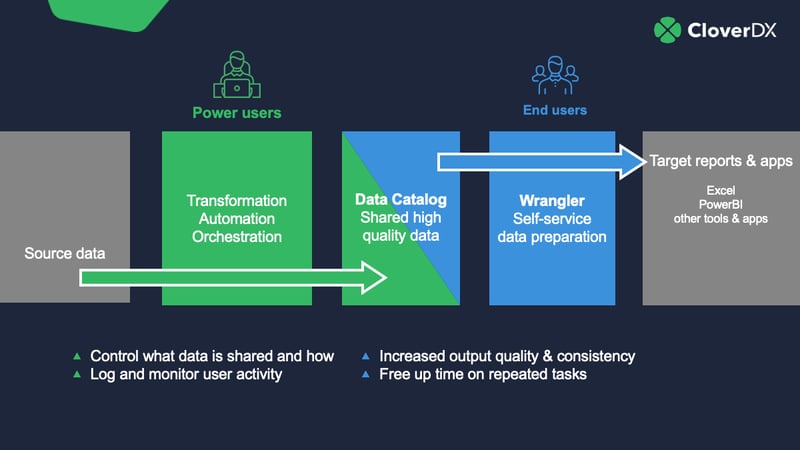Effective decision-making defines your ability to pinpoint gaps in the market, target the right customers, and prioritize your most impactful projects.
But in a complex and fast-paced environment, you can’t rely on intuition to make the right choices. You need data.
Yet, despite the evidence that a data-first approach leads to improved business outcomes, many organizations are still failing to take advantage. Less than a quarter of companies describe themselves as data-driven.
If you want to outpace your competitors by adopting a data-driven approach, the first step is to understand the problems you face. In this article, we’ll identify the four key barriers to making data-driven decisions, and explore how a data integration platform can help you tackle them.
4 barriers to making data-driven decisions
1. Lack of a data-first culture
It’s tempting to see working with data as a technical problem — something for your IT team to solve. But the right mindset is as important as the right toolset. 92% of executives cite cultural issues as the key barrier to establishing a data-driven culture, according to a recent survey.
The shift to a data-driven approach will be difficult for some. Senior leaders will already have a well-developed approach to making decisions. This may be something they’ve refined over decades — and it got them to where they are today.
Pivoting to a data-driven approach means asking them to modify or even completely transform the way they work. Yes, they’ll need to learn new skills and adopt new technologies. But more fundamentally, they will need to think differently about how they make decisions.
This is a big ask. As the saying goes, old habits die hard. Without adequate support to make the shift — and clear communication about the benefits of doing so — they’re likely to stick with the tried and tested approach.
2. Limited access to data
Embedding data into your decision-making process means having it on hand when you need it.
But if the data you need is distributed across multiple different systems and managed by different teams, assembling it can be time-consuming. Some teams may have adopted a silo mentality, making them reluctant to share what they have. Others may still use legacy systems, making the data difficult to access.
And of course, you can’t access data if you don’t know it exists. If you have limited visibility of what data is available, it’ll take some detective work to track down everything you need. And no matter how much time you invest, you can still overlook an important source of information.
The result? You feel confident your decisions are data-driven — but in reality, you’re missing a key piece of the puzzle.
3. A strained relationship between IT and business users
Your IT team is at the core of your data strategy. From sourcing and implementing the necessary infrastructure to taking the lead on data governance, their work will be key to improving your overall data maturity.
At the same time, your IT team is also responsible for the day-to-day practicalities of managing data access and providing technical support. They will play a vital role in ensuring business users can engage with data to support their decisions.
But with so many different priorities to balance, your IT team will face an increasing burden as you shift toward a data-driven approach. A sudden influx of access or support requests can prove difficult to manage — and they still have their own mission-critical projects to tackle.
As a result, business users may start facing bottlenecks in getting data support, while IT workloads can become a pressing challenge. This kind of environment does not enable a collaborative approach. And without data collaboration, you’ll struggle to support data-driven decisions.
Giving business users access to curated, reliable data with CloverDX Data Catalog4. Routine tasks taking up too much time
To turn data into actionable decisions, you need to analyze and interpret it effectively. This is challenging work, but it’s critical to success.
If the data you receive requires extensive preparation, this essential step is delayed. Consolidating data from different sources, identifying inconsistencies, excluding irrelevant information… all of these tasks can take up significant time — time you could have spent deriving actual value from the data.
Ultimately, you may find this undermines the value of engaging with the data in the first place. If speed is a priority, or your workload is tight, the trade-off may be hard to justify.
Enable business users to transform data - without needing a data engineerHow a data integration platform can support data-driven decisions
Transforming your decision-making process is not easy. With 70% of digital transformation projects ending in failure, it’s clear that these kinds of large-scale shifts come with significant risks.
But the risks of being left behind are far greater. Research shows that data-driven enterprises outperform their competitors. With 93% of companies planning to increase their investments in data, it’s worth being bold and embracing change.
And rest assured, there are ways to make the transition smoother.
The first step is finding the right tool. A data integration platform can help support data-driven decisions by:
- Providing a single, centralized source of data. A live data catalog helps eliminate data silos by giving users a clear view of the available data. And by supporting self-service data access, your IT team will be freed up to focus on their strategic priorities.
- Improving data quality. Automated validation processes can flag and solve data issues as they emerge. The data will arrive on your desk clean, consistent, and ready to use. You’ll spend less time on preparation and more time on analysis.
- Supporting business users to engage in data analytics. With no-code data transformation tools, you won’t need to wait on IT support to engage with data in depth. With a reduced time-to-insight, you can turn data into decisions faster.
To get a better idea of what this looks like in practice, book a demo with CloverDX. Our data integration platform supports business users to get the data you need, when you need it.
And with the ability to build custom automations by recording and repeating the steps of your data preparation process, you’ll save significant time on repetitive manual tasks.









